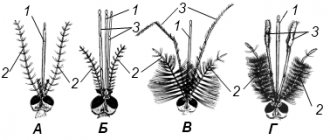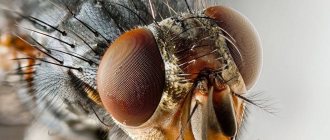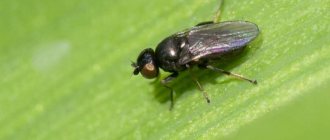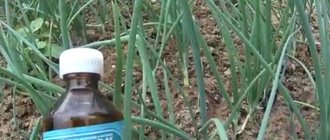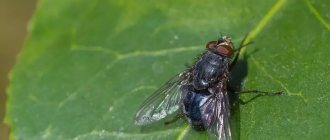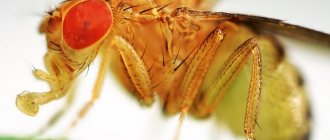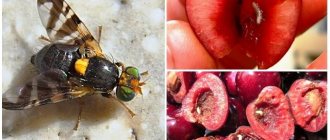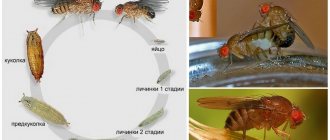What is the name of a small slender striped fly - very similar to a wasp
This insect can be found very often. A small fly with a striped body is able to quickly flap its wings while hovering in the air.
Many people get scared, mistaking it for a wasp, and are afraid of being stung, but the wasp does not have such ease of flight.
In fact, this insect is absolutely harmless, since it has neither a sting nor poisonous glands. What is the name of the small slender striped fly that looks very similar to a wasp? We need to figure it out.
Features of a slender wasp-like fly
When asked what the small, unusually slender striped fly is called, every biologist will answer: it is a hoverfly.
It belongs to the Diptera family of the short-whiskered suborder, which is very extensive - more than 6,000 species.
Most often you can find:
Among these species there are those that are useful to humans, and there are also garden pests.
Appearance
The slender striped fly, called the hoverfly, looks like a wasp only at first glance.
Upon closer examination, there are many differences:
Why are these insects so similar? If for a wasp such a bright color is a warning about its danger, then the hoverfly is camouflaged in this way.
Not having such a formidable defense in the form of poison as a predator similar to it, it repeats its coloring for self-defense, escaping from enemies.
This phenomenon is called mimicry.
With its help, a striped fly, similar to a wasp, pretends to be it. In flight, the insect's wings make a special murmuring sound, for which it received the name hoverfly.
There are a huge number of species of syrphids - and this is another answer to the question of what the striped fly is called. They differ greatly from each other depending on their habitat.
Entomologists even have such a specialization - syrphidologist. Among the entire vast world of insects, they chose this unusually slender striped fly to study.
Life cycle and reproduction
The first adult flies appear in late spring, and mating occurs at the end of July. To lay eggs, the female chooses a place where the larvae will have plenty of food.
The further cycle of metamorphosis is as follows:
During the development of the larva of some species of striped fly, up to 2000 insect pests become its prey.
Habitats and food
The striped hoverfly has colonized almost the entire territory of the earth's land. It's only too cold for her in Antarctica.
The habitats are very diverse and depend on the type of insect and the type of food that the larvae prefer.
Among the representatives of this family there are those whose larvae are herbivorous, and there are also predators among them. But this only applies to larvae.
All adults feed on pollen and nectar. The most preferred plants for them are complexly colored and umbrella plants, fruit bushes and trees.
Harm and benefits of the hoverfly
Most hoverflies are undoubtedly useful to humans. They not only pollinate plants in the absence of bees, their larvae free the garden and vegetable garden from pests.
Humans only have complaints about the onion hoverfly. Its larvae enjoy eating not only onions and garlic, but also bulbous flowers.
The harm from them can be very great.
In order not to lose the harvest, you will have to take measures:
When using chemicals, you need to be careful and take into account the harm they cause to beneficial insects.
Conclusion
The striped fly, similar to a wasp, is not capable of biting a person due to its biological structure.
On the contrary, the vast majority of species can become its allies in the fight against insect pests.
Experienced gardeners even recommend specially planting umbrella plants in places where pests may accumulate in order to attract these beneficial insects. This is much better than using pesticides.
Video: The appearance and sound of a hoverfly flying
Source
What insects are similar to wasps?
You can often distinguish a wasp from another insect by its size, the shape of its abdomen, or the arrangement of stripes on its body. The slightest deviation from a biological description is difficult to grasp for a person far from science. There are many species that masquerade as dangerous predators.
For more information about wasps and the features of their appearance with a description, read the article here.
Striped fly
Temnostoma wasp is a large fly from the hoverfly family, very similar to a wasp. On a long body (up to 18 mm) there are 2 transparent wings. In the center of the dark head there is a shiny stripe and reddish mustache. There are thin golden hairs on the chest and scutum. The oval abdomen is covered with transverse yellow-black lines.
Attention! Sometimes the marks merge, leaving a narrow brown spot.
Wasp-like flies live in deciduous forests where there is a lot of rotting vegetation. Found in river valleys and mountains. Temnostoma axialis is common in:
- Europe;
- Asia;
- North Africa;
- Greenland;
- America.
Predator
A large black insect, similar to a wasp, belongs to the order Hemiptera. More than 7 thousand predatory bugs are known that live in North America, Europe and Africa. 90 species are found on the territory of the former USSR. They prefer to hide in the grass, in the greenery of trees and between stones.
Important! They can settle near human habitation, in bird nests and abandoned burrows.
Carnivores have long hind legs and short forelimbs. Bedbugs have a narrow head, which gradually turns into a neck. Huge bulging eyes stand out against the general background. The complex oral apparatus in the form of a trunk consists of 3 segments. The insect's resemblance to a wasp is achieved due to contrasting black and orange stripes on the abdomen.
Nocturnal predators hide in a safe place during daylight hours, and come out to hunt in the dark. Bedbugs wait in ambush for a long time, creep up to a close distance, jump sharply and inject poison into their prey. The toxin enzyme paralyzes the victim and gradually digests the tissue. The predator thrusts its trunk into the body and sucks out the contents.
Females lay light-colored eggs in loose soil. After 60 days, tiny larvae appear and develop within six months. Young bugs are more aggressive and voracious than adult specimens. Tropical species feed on the blood of animals and people; European individuals prefer insects.
Predators, like wasps, can bite through human skin. A painful injury causes swelling and rotting of the tissue around the injury site. To avoid consequences, a poisonous predator should not be handled with unprotected hands. Bedbugs are held with tweezers and hands are protected with thick gloves.
Climaciella brunnea
The insect is very similar to a wasp, with a long body, and has huge limbs like a praying mantis. A representative of the mantispid family can be recognized by its thin, graceful body, colored brown with yellow horizontal stripes. Predators have well-developed enlarged front legs, which they use to grab prey. Males live only in the spring before mating.
Females lay eggs in wasp colonies. The hatched parasitic larvae attach to the body of the hosts and move to new territories. Adults often hunt in plants, using nectar as a supplementary food source. Representatives of the species are found only in North America.
What does it look like
Hoverflies, also known as syrphids, are a large family with about 6,000 species. Externally, the striped fly from the family Syrphidae really resembles a formidable wasp, bee or even bumblebee. This feature (mimicry) allows the insect to protect itself from a bird that wants to feast on it. After all, birds try not to come into contact with wasps, fearing their sting and poison.
The body size of an adult hoverfly is 10-12 mm; large specimens with a body size of up to 25 mm are also found. The main feature of the difference between insects of this species is the absence of hard hairs, the owners of which are representatives of other fly families. Like a bumblebee, the fly's dark yellow striped body is covered with fine hair. But unlike these insects, hoverflies lack a second pair of wings, which gives them the opportunity to hover in flight for a long time and abruptly change the direction of their movement. The hoverfly has light short legs and a moderate length proboscis (a photo of a wasp-like fly is presented below).
Lifestyle
Like almost all Hymenoptera, hornets are collective insects. They live in large colonies in self-built cellular structures. Just like wasps and bees, only in smaller numbers. The hornets' nest is also larger in size than the wasps' nest.
Typically, these large wasps prefer to use hollow trees, attics of houses, occupied beehives, as well as animal holes and caves as shelters for their homes.
These wasps build their homes in several tiers, horizontally. The material for construction is chewed pieces of wood bark, most often birch, moistened with saliva. Therefore, such papyrus material is not white, but rather a brownish tint, while to the touch it resembles thin paper, something like paper foil, so to speak.
In created nests, hornets maintain a strict hierarchical system of relationships. At the head of the colony is the queen, which produces hundreds of eggs. She is protected by the rest of the family. All actions of its members are aimed at preserving the queen, and therefore the colony itself.
Each insect is like a cog in the system. Workers spend all their active time searching for food for the queen and the younger generation in the form of larvae. Among them there are also “cleaners” who perform the functions of “nannies” for the larvae and also clean the nest.
In fact, during the day, only the female, larvae and a number of workers and “nurses” are in the nest to maintain the colony’s defenses. The rest of the family visits the nest only at night to sleep. The hornets' nest is somewhat reminiscent of a feudal castle, with a queen, soldiers, artisans and servants. Just a little simplified.
Types of hoverflies
Such striped flies have many varieties: in the world - up to 60 thousand, in Russia their number is 800. All types of hoverflies are distinguished by the different arrangement of yellowish and black stripes, as well as the diet of their larvae: some of them are herbivores, others are predators, still others eat tree bark.
The most common of them:
- The common hoverfly or flower fly with yellow stripes, reaches 12 mm in length, is a good pollinator, the larvae of which destroy garden pests;
- Onion hoverfly (Delia antique) – its size is about 1 cm, the larvae feed on the juice and pulp of bulbous plants;
- Wasp fly (Temnostoma vespiform) - a fly similar to a wasp in coloring and body shape, size up to 18 mm, its larvae consume rotten wood;
- The tenacious bee fly (Eristalis tenax) is a fly similar to a bee, 15 mm long, darker in color;
- Aquatic hoverfly or eristalis fly (Eristalis) - lives near standing ponds, swamps or puddles with musty water, has a special proboscis for breathing in order to consume air from the surface;
- Tufted hoverfly wasp (fasciolatum).
Harm and benefits of the hoverfly
Most hoverflies are undoubtedly useful to humans. They not only pollinate plants in the absence of bees, their larvae free the garden and vegetable garden from pests.
Humans only have complaints about the onion hoverfly. Its larvae enjoy eating not only onions and garlic, but also bulbous flowers.
Larvae laid by onion hoverfly
The harm from them can be very great.
In order not to lose the harvest, you will have to take measures:
- if the feathers turn yellow, the plant should be checked for the presence of larvae; if there are any, remove it and burn it;
- carry out treatment with insecticidal preparations;
- observe crop rotation;
- sow carrots and onions together; the hoverfly does not like the smell of carrots;
- After harvesting, disinfect the soil with a solution of copper sulfate.
When using chemicals, you need to be careful and take into account the harm they cause to beneficial insects.
What does it eat?
Adults feed on pollen and plant nectar. Most often, a fly like a wasp is found on flowering plants, plantings of parsley, dill, and carrots. She does not disdain a variety of meadow grasses, fruit trees and shrubs. After all, the basis of insect nutrition is the sugar contained in nectar. It is he who replenishes the energy reserves of a flying insect. Pollen is a source of protein, which is necessary for the proper growth and development of eggs.
What does it look like
Hoverflies, also known as syrphids, are a large family with about 6,000 species. Externally, the striped fly from the family Syrphidae really resembles a formidable wasp, bee or even bumblebee. This feature (mimicry) allows the insect to protect itself from a bird that wants to feast on it. After all, birds try not to come into contact with wasps, fearing their sting and poison.
The body size of an adult hoverfly is 10-12 mm; large specimens with a body size of up to 25 mm are also found. The main feature of the difference between insects of this species is the absence of hard hairs, the owners of which are representatives of other fly families. Like a bumblebee, the fly's dark yellow striped body is covered with fine hair. But unlike these insects, hoverflies lack a second pair of wings, which gives them the opportunity to hover in flight for a long time and abruptly change the direction of their movement. The hoverfly has light short legs and a moderate length proboscis (a photo of a wasp-like fly is presented below).
How does it reproduce
The summer of flies begins at the end of May, beginning of June. The mating season of hoverflies usually occurs in July. One female lays up to two hundred eggs. She can place them in the grass, on plant stems, tree branches and on the soil surface (the place of oviposition usually depends on the type of insect). Thus, the onion hoverfly, which lives mainly on onions, lays eggs on the feathers of the crop.
The eggs usually take 8-12 days to develop. The legless, sedentary larvae that emerge from them resemble a flexible leech of a green, pale yellow or pinkish hue. The internal organs are visible through the thin skin. The length of the syrphid at this stage of development is about one centimeter.
The type of feeding the larvae may differ in is:
Hoverfly larvae
In this way, the larvae feed and grow for 2-3 weeks, after which they move to the next stage of their development - the pupal stage.
The hoverfly pupa has a teardrop-shaped body. Pupae that remain over the winter are usually brown in color; summer pupae are light in color. After 10-14 days, an adult individual emerges from the puparia, which after 1-2 hours becomes capable of flight. With the onset of cold weather, the new generation of caterpillars hides for the winter.
Medicine
During the First World War, the unexpected property of carrion fly larvae settling in festering wounds was discovered. It turned out that the larvae of green carrion flies ( Lucilia
), blue carrion flies ( Calliphora
) and others, feeding on decaying tissues of wounds, not only remove these tissues and small fragments of bones, but also prevent the proliferation of pathogenic bacteria with their secretions. In addition, they secrete allantoin, a substance that promotes wound healing. However, flies taken from the natural environment can introduce tetanus bacilli or gangrene bacilli into wounds. Therefore, for the clinical treatment of difficult-to-heal wounds, laboratory-reared (sterile, that is, free from pathogens) larvae are used.
About harm and benefit
Not everyone knows that the hoverfly is not capable of biting, since it has neither a sting nor poison. Speaking about the harm and benefits of these “false” wasps, everything depends directly on their type.
The larvae of predatory hoverfly species are of great benefit. They are the best protectors of fruit trees and shrubs, destroying various harmful insects. Hoverfly larvae are also pollinators of flowering crops, which is especially necessary in mountainous areas due to the lack of bees.
Quite the opposite can be said about herbivorous hoverflies. Such flies are a source of great problems for owners of garden plots, causing damage to onions, garlic, hyacinth bulbs, daffodils, gladioli and tulips. As a result, damaged plants begin to hurt and dry out. The bulbs of flower crops suffer no less, not producing good reproduction.
The wasp is famous for its striking coloring, hostile behavior, addiction to sweets, and painful sting.
Insects that resemble a wasp differ both in habits and way of life from the Hymenoptera. The phenomenon that imitates an image is called protective camouflage. Research confirms that pests are loyal to their own kind.
Benefits and harms
Hoverflies can be classified as predatory insects, as they feed on plant foods and insect pests. Adults feed on pollen and plant nectar. Therefore, hover flies can be classified as pollinating insects. Insects give the greatest preference to umbelliferous and asteraceous plants. They do not disdain a variety of meadow grasses, fruit trees and shrubs.
The basis of insect nutrition is sugar, which is contained in nectar. It is he who gives the hoverflies energy. And pollen provides the protein necessary for the growth and development of eggs.
The hatched larvae differ in their feeding habits. Some feed on rotting wood, while others live and develop in water. There are exotic species that eat and process manure. Most of the larvae prefer aphids. Therefore, they can be considered true protectors of gardens. Many amateur gardeners specially plant the trunk circles of berry and fruit trees with umbrella crops in order to attract hoverflies to the garden to prevent aphid attacks.
But there are varieties of hover flies that feed on lily crops. It is these specimens that can cause damage to the crop by eating the bulbs of flower crops and damaging onions and garlic.
An interesting insect is the hoverfly. Despite the fact that some species can eat cultivated plants, in general they are assistants to humans. In remote mountainous areas, where there is a shortage of bees and wasps, they pollinate plants and increase their productivity. Great help is provided by eating aphids and spider mites in the garden. This protects the trees from pests. And it’s just interesting to watch them move in the air.
We are surrounded by a diverse world of insects: from small spider bugs that are not even visible to large bright butterflies that delight the eye. And among this wide variety of creatures there are flies - small winged insects, completely ugly to look at. They are not favored because of their annoyingness and intrusiveness, but worst of all, they are carriers of various microorganisms and bacteria that can cause various diseases: from simple poisoning to tuberculosis and typhus. We are surrounded by a large number of species of flies, which we need to be able to recognize so as not to be confused with other insects that are harmless to humans.
Large striped fly
Syrphids, or hoverflies, represent a family of 6,000 species. Outwardly they resemble bees, wasps, and bumblebees. Widely distributed in all regions except Antarctica, desert and tundra zones. The characteristic sound that the wings make is the basis for the name.
The wasp-like fly is distinguished by its harmlessness to humans. It is often observed in vegetable beds with carrots, dill, celery, and parsley. The diet of adult syrphids consists only of flower nectar and pollen. They belong to pollinating insects.
Feeding of syrphid larvae
Hoverfly larvae look like small leeches. The wrinkled body has a green or yellowish color. Mobility is not typical for legless individuals. Meals include:
Physical activity is developed only when hunting aphids. The hoverfly rises, sways from side to side, quickly attacks the victim, and absorbs it. Then, in search of food, the larva moves, trying to roll its body weight.
For your information. Flies, similar to bees, have a beneficial effect on agricultural areas.
The basis of the sirfid menu is plant nectar sugar, which replenishes the insect’s energy reserves. The primary source of protein is pollen, which is required for the proper development and growth of eggs.
The attentive mother hoverfly lays her eggs directly into the aphid nursery.
The period of development of murmuring larvae ranges from 15 to 20 days. The gluttony of young animals is amazing: by the end of their growth they eat up to 200 aphids, destroying about 2000 small insects during their existence.
Note! Syrphid larvae feed not only on plant tissues - the diet of exotics includes processed wood or manure products.
Flies that bite: are they dangerous?
Among the flies there are poisonous and biting ones. Of the former, the most popular is the tse tse fly (African fly). Everyone has heard about it, at least in passing. Lives in the hot climate of Africa, settling near swamps and marshy places. It feeds on the blood of cattle, but will not miss the opportunity to bite a person. And if this happens, the victim will become ill with a deadly disease that destroys the central nervous system and immunity.
Tsetse fly
African fly is the common name for the entire genus, which includes 23 species. Everyone is dangerous and nothing good will come from meeting such an enemy. Externally, the tsetse is more similar to a horsefly than a housefly: it also folds its wings on top of each other and has a characteristic stinging proboscis. Living in the wild, it bites small animals, moving closer to humans - livestock and people. The disease carried by the African fly is called "sleeping sickness" and causes paralysis and death.
But this is exotic, let's return to local parasites. Are any of them poisonous? No, but almost everyone carries various infections on their paws. That is why food on which an insect has crawled should not be eaten. At a minimum, you can get a gastrointestinal disorder, and at a maximum, dysentery or tuberculosis.
However, among the ordinary ones there are those that bite. You will be surprised, but it is not the usual housefly that attacks, but its bloodthirsty counterpart - the zhigalka. Externally, the species are no different, except for the structure of the proboscis, but no one will pay attention to this.
This is interesting! Throughout the summer, zhigalki live near livestock. These are blood-sucking flies: they bite cows, sheep, pigs and other domestic animals without touching humans. With the onset of cold weather, biting pests move into apartments and attack people in search of food. That is why it is popularly believed that by autumn flies “get wild”, become angry before they die and begin to bite.
Fly fly
The zhigalka is one of the most unpleasant species, because along with the bites it can introduce an infection, causing sepsis to develop. She is also a carrier of anthrax. And if the definition “poisonous” does not suit her, then “dangerous” certainly does.
Wohlfart fly
Another unpleasant representative of the fly tribe is the Wohlfarth fly, which is the causative agent of myiasis in livestock and humans: it lays larvae directly on the skin, after which they penetrate inside the body and cause extensive inflammatory foci. The Wohlfarth fly mainly attacks sheep and goats.
Deer bloodsucker
Wild animals also suffer from parasites. For example, deer fly (deer louse, elk tick, deer bloodsucker). It feeds on the blood of large animals, living permanently on their bodies. The deer bloodsucker has nothing in common with the tick; it simply becomes similar to it when, settling on the host, it sheds its wings. It flies poorly, reluctantly, prefers to live in fur, feeding on blood. Despite the obvious name, the deer bloodsucker attacks foxes, wild boars, birds and even humans.
Until now, getting acquainted with the world of flies, we have seen only the negative. Is there anything positive about these insects? Let's answer this question too.
A fly that looks like a bumblebee
Bumblebee
Volucella, or bumblebee fly, or hoverfly, belongs to the subfamily Eristalinae of the genus of hoverflies.
The murmur is a migratory insect. Males are often territorial.
Bumblebee flies have a distinctive plume awn and a head that flares downward. Two black bands stand out on the hairy abdomen.
Bumblebees are bumblebee imitators that lay eggs in their nests. The appearance of an insect is often deceiving. The bumblebee fly, which peacefully collects pollen, is a merciless enemy of wasps. The larvae live in the hives of social wasps and bumblebees and feed on eggs, pupae, and adults. Some bumblebees feed on the remains of decomposed organic matter. Carrion larvae belong to the genus Vespula.
Interesting. A bumblebee-like larva sometimes crawls out of a wasp or bumblebee nest and climbs into a person’s home to find a cozy place for metamorphosis.
Volucella inanis is one of the species. The insect is called a devastating insect, but does not have a sting and feeds on nectar. The culinary preferences of the predatory insect are devouring the larvae of hornets, bumblebees, and wasps. The harmless fly is found in different regions of Russia.
On a note. Carl Linnaeus, a famous Swedish scientist, discovered and classified the devastating bumblebee in the 18th century.
Bumblebee proboscis
In the summer, furry butterflies are spotted on honeysuckle flowers, which are easily confused with bumblebees:
We are talking about the bumblebee, or honeysuckle hawk. The insect extracts nectar with an elongated proboscis. The emergence of the butterfly is observed from May to July.
The appearance of caterpillars is associated with the height of summer. Individuals are characterized by:
Caterpillars like to settle in low crops and eat young leaves. By the end of the summer season they are at the pupal stage, so the pests are going to spend the winter.
The proboscis is easy to detect by its feeding habits: snowberry and honeysuckle, the leaves of which are eaten by the caterpillars.
For prevention, you will need to periodically inspect the plants and take appropriate measures.
When seeing single individuals, bumblebees make do with collecting caterpillars by hand. In case of mass damage, it is appropriate to use insecticides:
Necrophages
Necrophagous fliesThe names of fly species can often be misleading. Such a species as the “dust fly” does not exist in nature. This name most often hides lucilia, which belongs to the group of necrophages. In the garbage dumps themselves, you can find any synanthropic species, including fruit flies. The most famous necrophagous flies include: Lucilia (green); gray meat; blue meat They all feed on animal carcasses, but also include food scraps, plant juices and excrement in their diet. Interesting! Necrophages are easy to distinguish from other dipterans: all these flies have red eyes. Some may have blood red (gray blowfly) or brick eyes (green).
Lucilia
A very common and well-known emerald green fly, capable of laying eggs on meat left unattended for a couple of minutes. They often lay eggs in open wounds, where larvae begin to develop by eating rotting flesh. The main habitat of these dipterans near human habitation is slaughterhouses. But larvae can also develop in animal excrement. It takes 1-2 days for the larvae to develop from the egg.
Blue meat
Medium sized insect. Distributed across all continents. Like the green one, it prefers slaughterhouses and decaying meat.
Gray meat
One of the most dangerous carrion flies. Outwardly, it is similar to an ordinary indoor one, but larger and with clearly visible bright red eyes on its head. The species is viviparous. The female only needs to touch the meat with her belly to lay the larva. When emerging, the larva immediately begins to bite into the meat. The location of the larvae's penetration can be determined by the appearance of liquid from decomposing meat.
Why is mimicry needed?
The traditional answer is to scare away predators. But among insectivorous birds there are many who feed on stinging insects. The color will not scare off such predators, but will attract them. Other birds, as observations by ornithologists and entomologists have shown, perfectly distinguish syrphids from wasps, bumblebees and bees by behavior and flight pattern.
But mimicry is not useless. Bumblebees use it to penetrate bumblebee nests. For other syrphids, their external similarity to dangerous insect species saves their lives during the flight of their chicks. When a bird approaches a flower, the flies quickly detach and fly away. Insects that have protection are confident in their safety and are in no hurry to fly away. The chick tries to catch prey, gets a sting in its tongue and no longer goes near insects of similar appearance.
Later, the bird will learn to distinguish flies from their dangerous prototypes, but during the mass emergence of chicks, mimicry saves the lives of many syrphids.
Danger and harm of bee fly larvae
Eristalis tenax, or milkweeds, are the larvae of the bee fly that live at the bottom of small and dirty ponds and lakes, puddles, and farm wastewater. To breathe, they float to the surface of the water and put out a long tube, which reaches up to 27 cm and is capable of decreasing and increasing. Because of their resemblance to the tail, beekeeper larvae are called rats.
The adult that hatches from the larva is the eristalia fly. It flies out in the autumn season and feeds on flower nectar.
In appearance and color it resembles a bee. The bee fly larva has an undeveloped head and no eyes. The underdeveloped mouth is covered with a fold. There are no legs, but growths are visible at the bottom of the body. The rat has 7 pairs of false legs: 6 on the abdomen and 1 on the chest. Thanks to them, the fly crawls. A two-centimeter cylinder with a long tube at the end, which allows it to live in polluted or oxygen-free waters.
Features of a slender wasp-like fly
When asked what the small, unusually slender striped fly is called, every biologist will answer: it is a hoverfly.
It belongs to the Diptera family of the short-whiskered suborder, which is very extensive - more than 6,000 species.
Most often you can find:
Among these species there are those that are useful to humans, and there are also garden pests.
Appearance
The slender striped fly, called the hoverfly, looks like a wasp only at first glance.
Upon closer examination, there are many differences:
Why are these insects so similar? If for a wasp such a bright color is a warning about its danger, then the hoverfly is camouflaged in this way.
Not having such a formidable defense in the form of poison as a predator similar to it, it repeats its coloring for self-defense, escaping from enemies.
This phenomenon is called mimicry.
With its help, a striped fly, similar to a wasp, pretends to be it. In flight, the insect's wings make a special murmuring sound, for which it received the name hoverfly.
There are a huge number of species of syrphids - and this is another answer to the question of what the striped fly is called. They differ greatly from each other depending on their habitat.
Entomologists even have such a specialization - syrphidologist. Among the entire vast world of insects, they chose this unusually slender striped fly to study.
Life cycle and reproduction
The first adult flies appear in late spring, and mating occurs at the end of July. To lay eggs, the female chooses a place where the larvae will have plenty of food.
The further cycle of metamorphosis is as follows:
During the development of the larva of some species of striped fly, up to 2000 insect pests become its prey.
Habitats and food
The striped hoverfly has colonized almost the entire territory of the earth's land. It's only too cold for her in Antarctica.
The habitats are very diverse and depend on the type of insect and the type of food that the larvae prefer.
Among the representatives of this family there are those whose larvae are herbivorous, and there are also predators among them. But this only applies to larvae.
All adults feed on pollen and nectar. The most preferred plants for them are complexly colored and umbrella plants, fruit bushes and trees.
Harm and benefits of the hoverfly
Most hoverflies are undoubtedly useful to humans. They not only pollinate plants in the absence of bees, their larvae free the garden and vegetable garden from pests.
Humans only have complaints about the onion hoverfly. Its larvae enjoy eating not only onions and garlic, but also bulbous flowers.
The harm from them can be very great.
In order not to lose the harvest, you will have to take measures:
When using chemicals, you need to be careful and take into account the harm they cause to beneficial insects.
Pest flies that live nearby
Melon fly
Among the insects there are garden pests: melon fly, raspberry fly, cherry fly, onion fly and cabbage fly. They should not be confused with Drosophila fruit flies, which, although they are close relatives, do not cause direct harm, as they feed on rotten fruits and berries.
This is interesting! Any fruit fly, unlike a fly, is a unique object of biological research: its genome largely coincides with the human genome. Most of our diseases have an analogue among these seemingly useless small insects. This is why the fruit fly is a valuable subject to study.
But let's return to garden pests. As you might guess, the cherry fly parasitizes cherries, the melon fly can destroy the harvest of honey-sweet fruits, and the raspberry fly attacks one of the healthiest berries. Onion larvae will eat the entire root crop. The cabbage fly is not particularly discerning and eats all cruciferous vegetables. The arrival of such pests in the garden is a real disaster. Adult insects feed on liquid food, but the larvae feed on the fruits in which the females deposit them. If you notice insects circling over the beds and garden trees, slightly smaller than ordinary flies, but very similar to them, immediately destroy them, otherwise the crop will be destroyed!
Cabbage fly
The cabbage fly eats cruciferous vegetables, including wild ones. Its invasion is especially dangerous for the garden due to its widespread distribution. The cabbage fly is one of the most voracious parasites on vegetable crops.
Hessian fly
Another pest that is dangerous on a larger scale is called the Hessian fly. Its larvae feed on cereals, preferring wheat and rye. The Hessian fly is more like a mosquito; it is not without reason that it is called the “bread mosquito.” According to legend, it came to our country with fodder brought by Hessian mercenaries back in 1776. It has taken root, become familiar, and causes enormous damage to domestic agriculture. The Hessian fly is dangerous because if the attack is not stopped in time, it can easily ruin the entire cereal harvest.
The forest pest is the fungus fly. Her children are the worms we all know, hopelessly spoiling boletus, boletus, russula, etc.
These insects are harmful and dangerous, but there are even worse ones. Let's get to know the bloodthirsty flies that bite.
